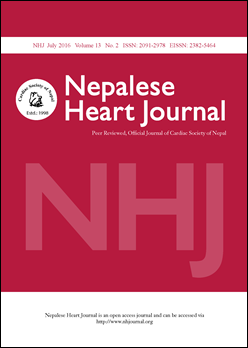Clinical Profile and Management in Children with Rheumatic Heart Disease in a Tertiary Cardiac Care Center of Nepal
DOI:
https://doi.org/10.3126/njh.v13i2.15562Keywords:
Acquired heart disease, children, Rheumatic heart disease.Abstract
Backgrounds and Aims: Rheumatic heart disease is the commonest acquired heart disease in children of developing world presenting earlier and with a more severe valvular lesion. This study was conducted to assess the clinical and demographic profile, pattern of valvular involvement and management modalities among children with rheumatic heart disease.
Methods: This was a hospital-based observational study, performed at Shahid Gangalal National Heart Center where all children less than 15 years of age with confirmed echocardiographic diagnosis of rheumatic heart disease from June 2015 to May 2016 were evaluated and relevant data were recorded.
Results: Two hundred and eleven children were diagnosed with rheumatic heart disease. The mean age was 11.9 ± 2.2 years with (100) 47.4% male and (111) 52.6% female. The median duration of symptoms among new cases was 1 year (interquartile range of 0.5 to 2 years). The most common symptom was dyspnea present in (187) 88.6% children followed by palpitation (34.5%). Mitral valve was most commonly affected in (141) 96.5% while isolated aortic valve involvement was seen in (8) 3.5%. Isolated mitral regurgitation was the most common lesion present in 118 (55.9%) children, while 50 (23.7%) children had combination of mitral and aortic regurgitation. Mitral valve was significantly more commonly affected in females and aortic valve commonly affected in males (p= 0.003).
Conclusions: Rheumatic heart disease although declining in developed countries, remains to be the commonest acquired heart disease in developing and underdeveloped countries. Efforts are needed to improve primary and secondary preventive measures.
Nepalese Heart Journal 2016; 13(2): 33-36Downloads
Downloads
Published
How to Cite
Issue
Section
License
This license enables reusers to distribute, remix, adapt, and build upon the material in any medium or format, so long as attribution is given to the creator. The license allows for commercial use.




